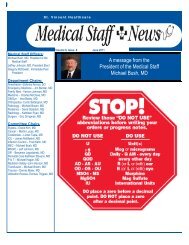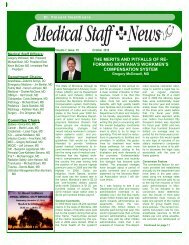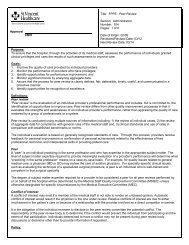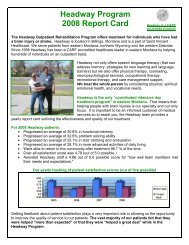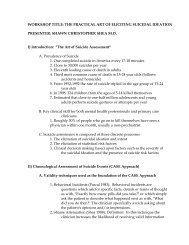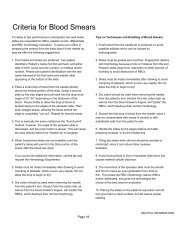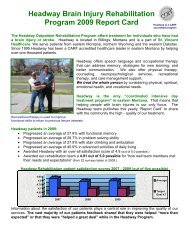Furie et al <strong>Prevention</strong> <strong>of</strong> <strong>Stroke</strong> <strong>in</strong> Patients With <strong>Stroke</strong> and TIA 259peutic partial thromboplast<strong>in</strong> time us<strong>in</strong>g <strong>in</strong>travenous hepar<strong>in</strong>has been associated with <strong>in</strong>creased risk <strong>of</strong> ischemic stroke. 484Intravenous hepar<strong>in</strong> can be easily titrated, discont<strong>in</strong>ued, andrapidly reversed with protam<strong>in</strong>e sulfate should bleed<strong>in</strong>grecur. Hepar<strong>in</strong> boluses are not recommended because studieshave shown that bolus <strong>the</strong>rapy <strong>in</strong>creases <strong>the</strong> risk <strong>of</strong> bleed<strong>in</strong>g.502 There is a paucity <strong>of</strong> data from prospective, randomizedstudies with regard to <strong>the</strong> use <strong>of</strong> o<strong>the</strong>r agents <strong>for</strong>anticoagulation <strong>in</strong> this sett<strong>in</strong>g.Hemorrhagic trans<strong>for</strong>mation with<strong>in</strong> an ischemic strokeappears to have a different course and natural history comparedwith ICH. In general, <strong>the</strong>se hemorrhages are <strong>of</strong>tenasymptomatic or cause m<strong>in</strong>imal symptoms, rarely progress <strong>in</strong>size or extent, and are relatively common occurrences. 503,504Some case series suggest cont<strong>in</strong>u<strong>in</strong>g anticoagulation even <strong>in</strong><strong>the</strong> presence <strong>of</strong> hemorrhagic trans<strong>for</strong>mation as long as <strong>the</strong>re isa compell<strong>in</strong>g <strong>in</strong>dication and <strong>the</strong> patient is not symptomaticfrom <strong>the</strong> hemorrhagic trans<strong>for</strong>mation. 505 Each case must beassessed <strong>in</strong>dividually on <strong>the</strong> basis <strong>of</strong> variables such as size <strong>of</strong>hemorrhagic trans<strong>for</strong>mation, patient status, and <strong>in</strong>dication <strong>for</strong>anticoagulation.Recommendations1. For patients who develop ICH, SAH, or SDH, it isreasonable to discont<strong>in</strong>ue all anticoagulants and antiplateletsdur<strong>in</strong>g <strong>the</strong> acute period <strong>for</strong> at least 1 to 2weeks and reverse any warfar<strong>in</strong> effect with freshfrozen plasma or prothromb<strong>in</strong> complex concentrateand vitam<strong>in</strong> K immediately (Class IIa; Level <strong>of</strong>Evidence B).2. Protam<strong>in</strong>e sulfate should be used to reverse hepar<strong>in</strong>associatedICH, with <strong>the</strong> dose depend<strong>in</strong>g on <strong>the</strong> timefrom cessation <strong>of</strong> hepar<strong>in</strong> (Class I; Level <strong>of</strong> EvidenceB). (New recommendation)3. The decision to restart antithrombotic <strong>the</strong>rapy afterICH related to antithrombotic <strong>the</strong>rapy depends on <strong>the</strong>risk <strong>of</strong> subsequent arterial or venous thromboembolism,risk <strong>of</strong> recurrent ICH, and overall status <strong>of</strong> <strong>the</strong>patient. For patients with a comparatively lower risk <strong>of</strong>cerebral <strong>in</strong>farction (eg, AF without prior ischemicstroke) and a higher risk <strong>of</strong> amyloid angiopathy (eg,elderly patients with lobar ICH) or with very pooroverall neurological function, an antiplatelet agent maybe considered <strong>for</strong> prevention <strong>of</strong> ischemic stroke. Inpatients with a very high risk <strong>of</strong> thromboembolism <strong>in</strong>whom restart <strong>of</strong> warfar<strong>in</strong> is considered, it may bereasonable to restart warfar<strong>in</strong> <strong>the</strong>rapy at 7 to 10 daysafter onset <strong>of</strong> <strong>the</strong> orig<strong>in</strong>al ICH (Class IIb; Level <strong>of</strong>Evidence B). (New recommendation)4. For patients with hemorrhagic cerebral <strong>in</strong>farction, itmay be reasonable to cont<strong>in</strong>ue anticoagulation, depend<strong>in</strong>gon <strong>the</strong> specific cl<strong>in</strong>ical scenario and underly<strong>in</strong>g<strong>in</strong>dication <strong>for</strong> anticoagulant <strong>the</strong>rapy (Class IIb;Level <strong>of</strong> Evidence C) (Table 10).VIII. Special Approaches to Implement<strong>in</strong>g<strong>Guidel<strong>in</strong>e</strong>s and Their Use <strong>in</strong>High-Risk PopulationsNational consensus guidel<strong>in</strong>es are published by manypr<strong>of</strong>essional societies and government agencies to <strong>in</strong>creasehealthcare providers’ awareness <strong>of</strong> evidence-based approachesto disease management. This method <strong>of</strong> knowledgedelivery assumes that <strong>in</strong>creased awareness <strong>of</strong> guidel<strong>in</strong>econtent alone can lead to substantial changes <strong>in</strong>physician behavior and ultimately patient behavior andhealth outcomes. Experience with previously publishedguidel<strong>in</strong>es suggests o<strong>the</strong>rwise, and compliance with secondarystroke and coronary artery disease preventionstrategies based on guidel<strong>in</strong>e dissem<strong>in</strong>ation has not <strong>in</strong>creaseddramatically. 506–510 For example, treatment <strong>of</strong>hypertension to reduce stroke risk has been <strong>the</strong> subject <strong>of</strong> manyguidel<strong>in</strong>es and public education campaigns. Among adults withhypertension, 60% are on <strong>the</strong>rapy, but only half <strong>of</strong> those areactually at <strong>the</strong>ir target BP goal, whereas ano<strong>the</strong>r 30% areunaware that <strong>the</strong>y even have <strong>the</strong> disease. 511 In a survey <strong>of</strong>physicians who were highly knowledgeable about target cholesterolgoals <strong>for</strong> <strong>the</strong>rapy, few were successful <strong>in</strong> achiev<strong>in</strong>g <strong>the</strong>segoals <strong>for</strong> patients <strong>in</strong> <strong>the</strong>ir own practice. 512 The use <strong>of</strong> retrospectiveper<strong>for</strong>mance data to improve compliance has producedsmall changes <strong>in</strong> adherence to guidel<strong>in</strong>e-derived measures <strong>in</strong>prevention <strong>of</strong> coronary artery disease. 506Systematic implementation strategies must be coupled withguidel<strong>in</strong>e dissem<strong>in</strong>ation to change healthcare provider practice.The Third Report <strong>of</strong> <strong>the</strong> Expert Panel on Detection,Evaluation, and Treatment <strong>of</strong> High Blood Cholesterol <strong>in</strong>Adults 513 identified <strong>the</strong> need <strong>for</strong> enabl<strong>in</strong>g strategies (eg, <strong>of</strong>ficerem<strong>in</strong>ders), re<strong>in</strong><strong>for</strong>c<strong>in</strong>g strategies (eg, feedback), and predispos<strong>in</strong>gstrategies (eg, practice guidel<strong>in</strong>es) to improve <strong>the</strong>quality <strong>of</strong> practice. One such example is <strong>the</strong> <strong>AHA</strong> voluntaryquality improvement program, Get With The <strong>Guidel<strong>in</strong>e</strong>s(GWTG), which has 3 <strong>in</strong>dividual modules on secondaryprevention <strong>of</strong> coronary heart disease, heart failure, and stroke.The GWTG–<strong>Stroke</strong> program was implemented nationally <strong>in</strong>2003; as <strong>of</strong> 2008, 1000 hospitals are participat<strong>in</strong>g <strong>in</strong> <strong>the</strong>program. Participation was associated with improvements <strong>in</strong><strong>the</strong> follow<strong>in</strong>g measures related to secondary stroke preventionfrom basel<strong>in</strong>e to <strong>the</strong> fifth year 514 : discharge antithrombotics,anticoagulation <strong>for</strong> AF, lipid treatment <strong>for</strong> LDL-C100 mg/dL, and smok<strong>in</strong>g cessation. GWTG–<strong>Stroke</strong> wasassociated with a 1.18-fold yearly <strong>in</strong>crease <strong>in</strong> <strong>the</strong> odds <strong>of</strong>adherence to guidel<strong>in</strong>es, <strong>in</strong>dependent <strong>of</strong> secular trends.O<strong>the</strong>r organizations have also recognized <strong>the</strong> need <strong>for</strong>systematic approaches. The National Institutes <strong>of</strong> HealthRoadmap <strong>for</strong> Medical Research was implemented to addresstreatment gaps between cl<strong>in</strong>ically proven <strong>the</strong>rapies and actualtreatment rates <strong>in</strong> <strong>the</strong> community. 515 To ensure that scientificknowledge is translated effectively <strong>in</strong>to practice and tha<strong>the</strong>althcare disparities are addressed, <strong>the</strong> Institute <strong>of</strong> Medic<strong>in</strong>e<strong>of</strong> <strong>the</strong> National Academy <strong>of</strong> Sciences has recommended <strong>the</strong>establishment <strong>of</strong> coord<strong>in</strong>ated systems <strong>of</strong> care that <strong>in</strong>tegratepreventive and treatment services and promote patient accessto evidence-based care. 516Although data l<strong>in</strong>k guidel<strong>in</strong>e compliance with improvedhealth and cost outcomes <strong>in</strong> acute stroke, secondary preventionhas been less well studied. The Italian <strong>Guidel<strong>in</strong>e</strong> Application<strong>for</strong> Decision Mak<strong>in</strong>g <strong>in</strong> Ischemic <strong>Stroke</strong> (GLADIS)Study demonstrated better outcomes, reduced length <strong>of</strong> stay,and lower costs <strong>for</strong> patients with acute stroke who weretreated accord<strong>in</strong>g to guidel<strong>in</strong>es. <strong>Guidel<strong>in</strong>e</strong> compliance andstroke severity were <strong>in</strong>dependent predictors <strong>of</strong> cost. 517,518 TheDownloaded from stroke.ahajournals.org by on March 8, 2011
260 <strong>Stroke</strong> January 2011<strong>Stroke</strong> PROTECT (Prevent<strong>in</strong>g Recurrence Of ThromboembolicEvents through Coord<strong>in</strong>ated Treatment) program exam<strong>in</strong>ed8 medication/behavioral secondary prevention measuresdur<strong>in</strong>g hospitalization and found good but variable compliancewith guidel<strong>in</strong>es at 90 days. There was no analysis <strong>of</strong> recurrencerates, quality <strong>of</strong> life, or healthcare costs <strong>in</strong> this population. 519 Ithas been proposed that l<strong>in</strong>k<strong>in</strong>g f<strong>in</strong>ancial reimbursement tocompliance might improve <strong>the</strong> quality <strong>of</strong> care <strong>for</strong> stroke survivors.A UK study exam<strong>in</strong>ed <strong>the</strong> relationship between <strong>the</strong> Qualityand Outcomes Framework (QOF), which calculated “qualitypo<strong>in</strong>ts” <strong>for</strong> stroke us<strong>in</strong>g computer codes and reimbursed physiciansaccord<strong>in</strong>gly. Higher-quality po<strong>in</strong>ts did not correlate withbetter adherence to national guidel<strong>in</strong>es, however, <strong>in</strong>dicat<strong>in</strong>g thatadditional research is needed to determ<strong>in</strong>e how best to effect andmeasure <strong>the</strong>se practices. 520Identify<strong>in</strong>g and Respond<strong>in</strong>g to Populations atHighest RiskStudies highlight <strong>the</strong> need <strong>for</strong> special approaches <strong>for</strong>populations at high risk <strong>for</strong> recurrent stroke and TIA,ei<strong>the</strong>r because <strong>of</strong> <strong>in</strong>creased predisposition or reducedhealth literacy and awareness. Those at high risk have beenidentified as <strong>the</strong> aged, socioeconomically disadvantaged, and specificethnic groups. 521–523The elderly are at greater risk <strong>of</strong> stroke and at <strong>the</strong> highestrisk <strong>of</strong> complications from treatments such as oral anticoagulantsand carotid endarterectomy. 524,525 Despite <strong>the</strong>need to consider different approaches <strong>in</strong> <strong>the</strong>se vulnerablepopulations, some trials do not <strong>in</strong>clude a sufficient number<strong>of</strong> subjects 80 years <strong>of</strong> age to fully evaluate <strong>the</strong> efficacy <strong>of</strong>a <strong>the</strong>rapy with<strong>in</strong> this important and ever-grow<strong>in</strong>g subgroup.In SAPPHIRE, only 11% (85 <strong>of</strong> 776 CEA patients) were 80years <strong>of</strong> age, and comparison <strong>of</strong> high- and low-risk CEAsdemonstrated no difference <strong>in</strong> stroke rates. 526 By contrast,trials <strong>of</strong> medical <strong>the</strong>rapies such as stat<strong>in</strong>s have <strong>in</strong>cludedrelatively large numbers <strong>of</strong> elderly patients with coronaryartery disease and support safety and event reduction <strong>in</strong> <strong>the</strong>segroups, although fur<strong>the</strong>r study <strong>in</strong> <strong>the</strong> elderly may still beneeded. 527–530The socioeconomically disadvantaged constitute that populationat high risk <strong>for</strong> stroke primarily because <strong>of</strong> limitedaccess to care. 531,532 As <strong>in</strong>dicated <strong>in</strong> <strong>the</strong> report <strong>of</strong> <strong>the</strong> AmericanAcademy <strong>of</strong> Neurology Task Force on Access toHealthcare <strong>in</strong> 1996, access to medical care <strong>in</strong> general and <strong>for</strong>neurological conditions such as stroke rema<strong>in</strong>s limited. Theselimitations to access may be due to limited personal resourcessuch as lack <strong>of</strong> health <strong>in</strong>surance, geographic differences <strong>in</strong>available facilities or expertise, as is <strong>of</strong>ten <strong>the</strong> case <strong>in</strong> ruralareas, or arrival at a hospital after hours. Hospitalized strokepatients with little or no <strong>in</strong>surance receive fewer angiogramsand endarterectomies. 533–536Many rural <strong>in</strong>stitutions lack <strong>the</strong> resources <strong>for</strong> adequateemergency stroke treatment and <strong>the</strong> extensive communityand pr<strong>of</strong>essional educational services that address strokeawareness and prevention compared with urban areas.Telemedic<strong>in</strong>e is emerg<strong>in</strong>g as a tool to support improvedrural health care and <strong>the</strong> acute treatment and primary andsecondary prevention <strong>of</strong> stroke. 537 <strong>Stroke</strong> prevention ef<strong>for</strong>tsare <strong>of</strong> particular concern <strong>in</strong> those ethnic groupsidentified as be<strong>in</strong>g at <strong>the</strong> highest risk. 132 Although deathrates attributed to stroke have decl<strong>in</strong>ed by 11% <strong>in</strong> <strong>the</strong>United States from 1990 through 1998, not all groups havebenefited equally, and substantial differences among ethnicgroups persist. 538 Even with<strong>in</strong> m<strong>in</strong>ority ethnic populations,gender disparities rema<strong>in</strong>, as evidenced by <strong>the</strong> factthat although <strong>the</strong> top 3 causes <strong>of</strong> death <strong>for</strong> black men areheart disease, cancer, and HIV <strong>in</strong>fection/AIDS, strokereplaces HIV <strong>in</strong>fection as <strong>the</strong> third lead<strong>in</strong>g cause <strong>in</strong> blackwomen. 539 black women are particularly vulnerable toobesity, with a prevalence rate <strong>of</strong> 50%, and <strong>the</strong>ir highermorbidity and mortality rates from heart disease, diabetes,and stroke have been attributed <strong>in</strong> part to <strong>in</strong>creased bodymass <strong>in</strong>dex. In <strong>the</strong> Michigan Coverdell Registry, 540 AfricanAmericans were less likely to receive smok<strong>in</strong>g cessationcounsel<strong>in</strong>g (OR, 0.27; CI, 0.17 to 0.42). The BASICProject noted <strong>the</strong> similarities <strong>in</strong> stroke risk factor pr<strong>of</strong>iles<strong>in</strong> Mexican Americans and non-Hispanic whites. 541 Therole <strong>of</strong> hypertension <strong>in</strong> blacks and its disproportionateimpact on stroke risk has been clearly identified, 542–544 yetstudies <strong>in</strong>dicate that risk factors differ between differentethnic groups with<strong>in</strong> <strong>the</strong> worldwide black population. 545For <strong>the</strong> aged, socioeconomically disadvantaged, and specificethnic groups, <strong>in</strong>adequate implementation <strong>of</strong> guidel<strong>in</strong>esand noncompliance with prevention recommendations arecritical problems. Expert panels have <strong>in</strong>dicated <strong>the</strong> need <strong>for</strong> amultilevel approach to <strong>in</strong>clude <strong>the</strong> patient, provider, andorganization deliver<strong>in</strong>g health care. The evidence <strong>for</strong> thisapproach is well documented, but fur<strong>the</strong>r research is sorelyneeded. 546 The NINDS <strong>Stroke</strong> Disparities Plann<strong>in</strong>g Panel,convened <strong>in</strong> June 2002, developed strategies and programgoals that <strong>in</strong>clude establish<strong>in</strong>g data collection systems andexplor<strong>in</strong>g effective community impact programs and <strong>in</strong>struments<strong>in</strong> stroke prevention. 547 The panel encouraged projectsaimed at stroke surveillance projects <strong>in</strong> multiethnic communitiessuch as those <strong>in</strong> sou<strong>the</strong>rn Texas, 541 nor<strong>the</strong>rn Manhattan,544 Ill<strong>in</strong>ois, 548 and suburban Wash<strong>in</strong>gton, 549 and strokeawareness programs targeted directly at m<strong>in</strong>oritycommunities.Alliances with <strong>the</strong> federal government through <strong>the</strong> NINDS,Centers <strong>for</strong> Disease Control and <strong>Prevention</strong>, nonpr<strong>of</strong>it organizationssuch as <strong>the</strong> <strong>AHA</strong>/<strong>ASA</strong>, and medical specialtygroups such as <strong>the</strong> American Academy <strong>of</strong> Neurology and <strong>the</strong>Bra<strong>in</strong> Attack Coalition are needed to coord<strong>in</strong>ate, develop, andoptimize implementation <strong>of</strong> evidence-based stroke preventionrecommendations. 550Recommendations1. It can be beneficial to embed strategies <strong>for</strong> implementationwith<strong>in</strong> <strong>the</strong> process <strong>of</strong> guidel<strong>in</strong>e developmentand distribution to improve utilization <strong>of</strong> <strong>the</strong>recommendations (Class IIa; Level <strong>of</strong> Evidence B).(New recommendation)2. Intervention strategies can be useful to address economicand geographic barriers to achiev<strong>in</strong>g compliancewith guidel<strong>in</strong>es and to emphasize <strong>the</strong> need <strong>for</strong>improved access to care <strong>for</strong> <strong>the</strong> aged, underserved, andhigh-risk ethnic populations (Class IIa; Level <strong>of</strong> EvidenceB). (New recommendation; Table 10)Downloaded from stroke.ahajournals.org by on March 8, 2011



